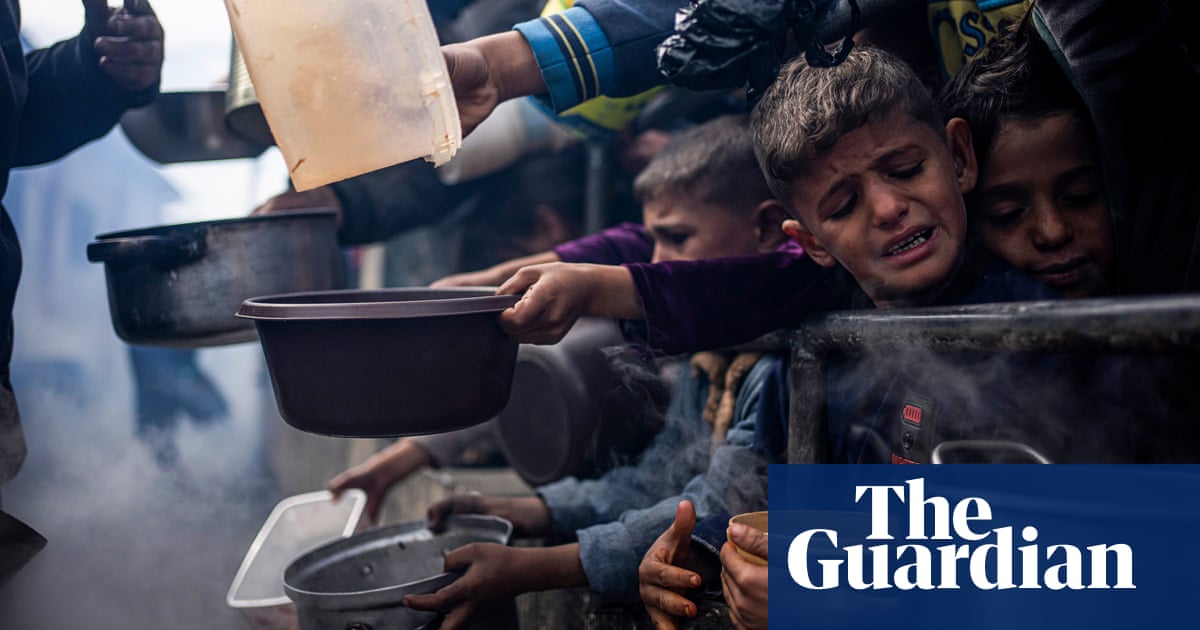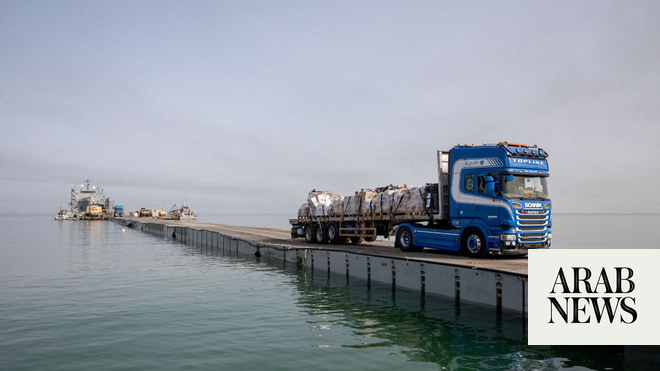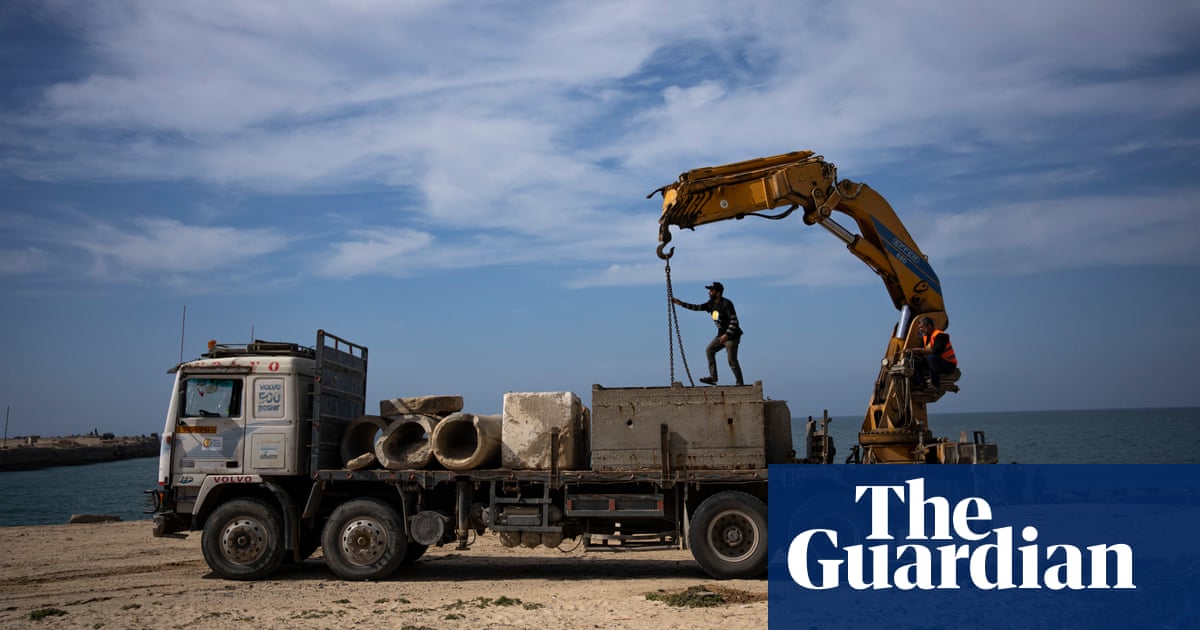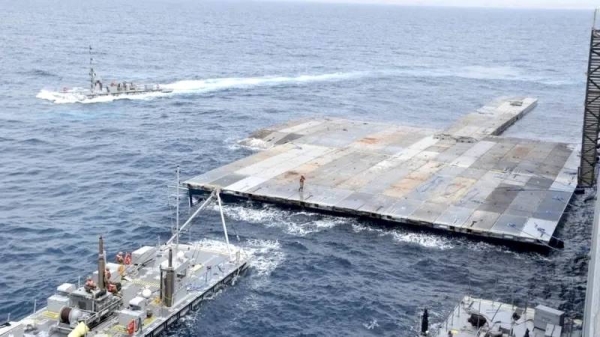
A giant floating pier is due to be completed in the next two weeks in the eastern Mediterranean from where it will be pushed towards the Gaza shore, but there is growing uncertainty over how useful the US project will be in containing a famine.
There are concerns in the humanitarian community that Israel has co-opted the pier plan, which Joe Biden touted as a way to bring about a “massive” increase in aid to Gaza, with one aid official saying the project was in danger of becoming a “smokescreen” for the planned invasion of Rafah.
US officials had said the pier was due to be in position by early May, after being built by engineers working off US naval vessels. However, a Pentagon spokesman, Maj Gen Pat Ryder, said that, while all the required ships were in place, the US military was still waiting for all the accompanying arrangements for delivering aid to be made before starting work on the pier and causeway.
“As I understand it, as of right now there has been no physical construction of the temporary pier or the causeway,” Maj Gen Ryder said on Tuesday, adding the military had to be sure “all of the pieces are in place and that you can begin operating”.
Ryder insisted: We’re still, based on all indications, on track to see an operating capability by the end of this month or early May.”
However, there is still a lack of clarity over how the aid will be distributed once it reaches Gaza. According to several aid officials, the current plan is to anchor it not off northern Gaza, where the threat of famine is most severe, but at a point halfway up the strip where the Israel Defense Forces (IDF) have a stronghold.
That would mean that food aid brought in via the dock would still have to pass through an IDF checkpoint at the Netzarim corridor, a military road that bisects the strip, and which has been a choke-point stopping humanitarian deliveries reaching the north.
Some UN and other humanitarian officials fear that the aid will be diverted south to camps set up for the more than 1 million people now sheltering in Rafah. The IDF wants them to move out so that it can conduct an offensive against Hamas units in Gaza’s southernmost city.
Such an offensive would inevitably mean the temporary closure of Rafah and Kerem Shalom crossings in southern Gaza, so the US-made floating dock would serve as a substitute, while at the same time diverting pressure on Israel to open northern crossing points to substantial aid traffic.
“One of the key arguments for having a dock was to put it further north so that suppliers could come in more directly to the north,” a UN official said, adding that what was actually being proposed looked more like a “smokescreen to enable the Israelis to invade Rafah”.
When Biden announced the scheme as one of the highlights of his State of the Union speech on 7 March, he presented it as a decisive step in delivering food aid. “This temporary pier would enable a massive increase in the amount of humanitarian assistance getting into Gaza every day,” he said.
A senior US official presented it at the time as a way of delivering food without having to use the IDF-run land crossings. “We’re not waiting on the Israelis,” the official said.
Since then, it has become clear that the IDF’s monopoly over security in Gaza allowed the Israeli authorities to influence where the dock should be placed.
The IDF’s bombing of an aid convoy in Gaza run by World Central Kitchen on 1 April, killing seven aid workers, had made security concerns a key obstacle to any form of independent distribution effort.
The US plan will involve a floating pier, anchored to the sea floor, where big ships will unload, and a floating 500-metre causeway connected to the shore. Smaller vessels would transport cargo from the pier to the causeway, where it would be loaded on to trucks for distribution. The ambition is for 200 trucks a day, carrying 2 million meals, to enter Gaza by this sea route.
The question of who should deliver food around Gaza had been argued over for some weeks before Friday, when the US humanitarian and development agency USAid announced an agreement with the UN’s World Food Programme (WFP).
The agreement was controversial within the UN as its agencies had previously agreed that all aid operations in Gaza should involve the Unrwa, the relief agency for Palestinian refugees across the region, which Israel is trying to sideline.
It was clear from the announcements on Friday that not everything had been worked out.
“Operational conversations continue with WFP to ensure safe and sustainable delivery of humanitarian assistance to Palestinian civilians in Gaza in an independent, neutral, and impartial manner,” a USAid spokesperson said. “This is a complex operation that requires coordination between many partners, and our conversations are ongoing.”
The WFP announcement was even more tentative. “The UN has agreed to work with the US and other partners on the maritime corridor as an additional route for relief to Gaza, on the condition that humanitarian principles can be ensured and that land access is also expanded,” a spokesperson said.
The UN agencies are nervous about becoming too identified with an IDF mechanism for delivering aid.
“The perception that would be created of humanitarians operating alongside the IDF in any way, shape, or form, would be ruinous for the reputation of humanitarians in Gaza. We would be seen to be collaborating,” a UN official said. “It would of course have knock-on consequences in terms of our safety and acceptance inside of Gaza.”
Stephen Morrison, senior vice-president at the Center for Strategic and International Studies, said the UN was highly resistant to the idea, but that they were “getting pushed and pulled”.
“What is unclear is: does this lead to the further degradation and marginalisation of Unrwa?” he said.
Meanwhile, a parallel scheme is being promoted by a private firm called Fogbow, made up of former US special forces, marines, CIA officers, a former diplomat, a former fund manager and a veteran UN aid official. Fogbow’s plan, which it calls Blue Beach, involves three barges capable of carrying 175 trucks each, sailing direct from Cyprus to the Gaza coast.
The Fogbow barges would come ashore close to the US causeway and the Israeli security perimeter but on the north side of the Netzarim corridor. The company is looking to partner with Palestinian businesses, including the Palestinian entrepreneur Bashar al Masri, to help warehouse food and distribute deliveries.
Fogbow was formed in 2022 with the idea of providing privately run humanitarian relief in difficult or hostile environments. The idea was shelved in 2023 but revived after the Gaza war broke out in October and the humanitarian situation in the strip became disastrous.
While Gaza would be Fogbow’s first venture, it believes its team has deep experience of logistics in extreme circumstances.
“These are folks who are rugged American types who feel that they can deal with the Israelis, to the Israeli inspectors, they can deal with the Palestinians, they can talk to the Cypriots, they can organise shipping and they can tie in with the US,” Morrison said.
Fogbow has set up a fundraising arm in Geneva, called Maritime Humanitarian Aid Foundation and run by another former US diplomat, Cameron Hume. The team has been touring world capitals looking for backing and believes it has pledges of support from the Gulf monarchies and Europe.
Several of the Fogbow team were stationed in Israel during their government service and are now seeking to leverage their relationships within the IDF to set up a privately run sea corridor. They could also take over the running of the US floating dock and pier when the US forces leave.
The existence of a privatised sea route would provide Israel with an alternative to dealing with Unrwa or the Palestinian Authority, neither of which the Israelis want to empower in Gaza.
However, humanitarian aid officials are concerned that the Fogbow venture, if it took off, could crowd out UN agencies and NGOs in the competition for scarce resources, such as trucks and drivers to distribute food around Gaza, and the time and attention of Israeli security screeners who are setting up a station in the Cypriot port of Larnaca to police the sea corridor.
If and when the maritime route opens and ships begin arriving at the US-made floating dock, it will be a spectacular, challenging but an extremely expensive and slow way of delivering aid.
“While private sector efforts to support aid agencies are appreciated, it’s crucial to ensure that humanitarian principles are upheld throughout these endeavours,” said Ziad Issa, the head of humanitarian policy at ActionAid UK.
Issa added: “A significant challenge remains with this plan: who will be responsible for delivering this aid on the ground? The time required for this new route to become operational is unlikely to address the urgent needs of those currently facing starvation and in dire need of food, water, and medical supplies.”
Humanitarian officials say there is a far easier method of delivering aid through land crossings in northern Gaza that could be opened at any time. Israel’s siege of Gaza has so far prevented trucks from entering in anything like the numbers needed.
“There is an easier, faster, more efficient, cheaper and quicker way to reach people in the north,” said Juliette Touma, Unrwa’s communications director. “It’s very easy and very straightforward. All it takes is political will.”












